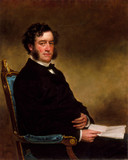At mid-century Charles Loring Elliott was the leading portraitist in New York City. When he was fifteen, Elliott and his family moved to Syracuse, New York. Determined to become a painter, in 1829 he went to New York City with a letter of introduction to John Trumbull (1756-1843), who allowed him to draw from casts at the American Academy of Fine Arts. He also spent about six months in the studio of William Rimmer (1816-1879). Essentially self-taught, Elliott spent about a decade working as an itinerant portraitist in western and central New York State. About 1839 he moved permanently to New York City, steadily gaining in ability, especially after his acquaintance with HENRY INMAN in 1844. The success of one of his portraits at the exhibition of the National Academy of Design in 1845 established Elliott as one of the city’s leading portraitists, and after the death of Inman in 1846 he was considered to have succeeded that artist as the foremost portraitist in New York. He was elected an associate of the National Academy in 1845 and an academician the following year. In 1854 he established a residence at West Hoboken, New Jersey, but kept a studio in New York. Until his death Elliott was in great demand as a portraitist and received almost all the most important private and civic commissions.
BIBLIOGRAPHY
E. Anna Lewis, "Art and Artists of America: Charles Loring Elliott, N.A.," Graham’s American Monthly Magazine 44 (June 1854): 564-68 § Tuckerman 1867, pp. 300-305 § Thomas Bangs Thorpe, "Reminiscences of Charles L. Elliott, Artist," New York Evening Post, September 30 and October 1, 1868, reproduced as a pamphlet, n.d. (on microfilm, Archiv. Am. Art, roll N52, frs. 641-46) § Theodore Bolton, "Charles Loring Elliott, an Account of His Life and Work" and "A Catalogue of The Portraits," Art Quarterly 5 (Winter 1942): 58-96 § Philip F. Schmidt, "Charles Loring Elliott (1812-1868): American Portrait Painter," Master’s thesis, University of Minnesota, 1955.

